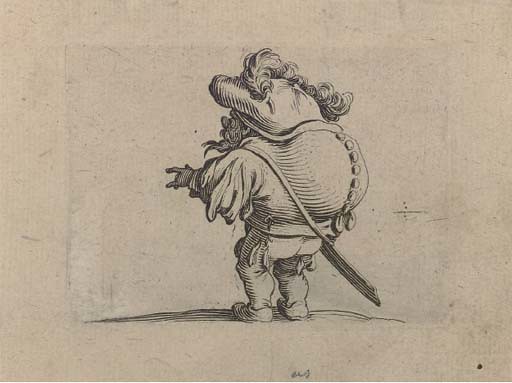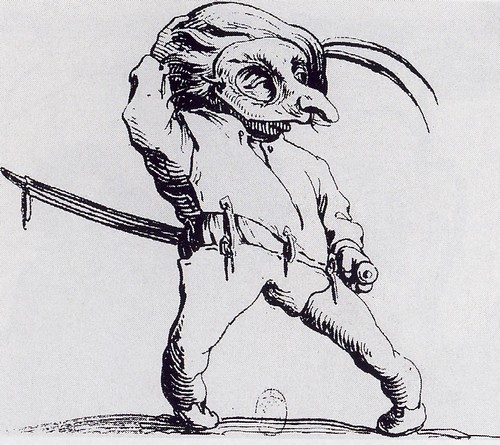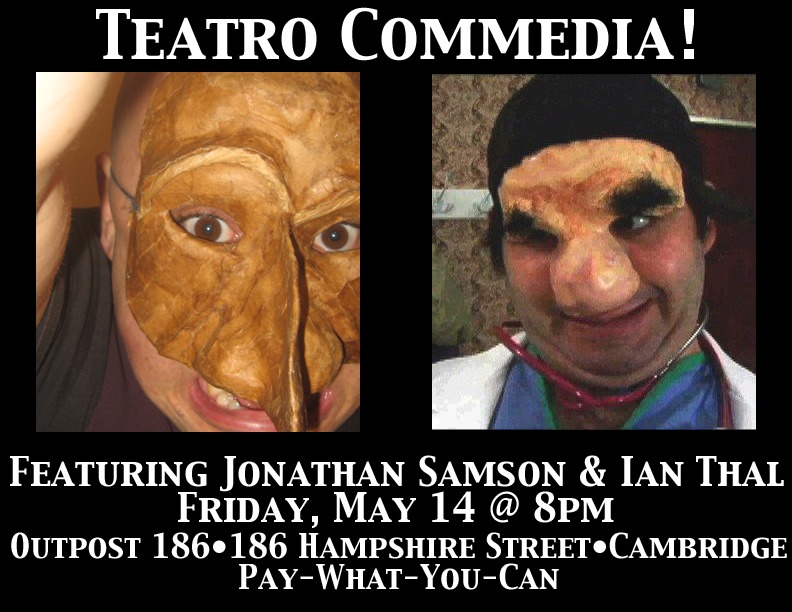In a recent conversation with my friend Cherie Konyha Greene about her trip through Italy to research a historical novel, we found ourselves asking "where did Shakespeare get the name for Launcelot Gobbo?" Cherie had found references to "Il Gobbo di Rialto" a statue of a hunched figure in front of the Church of San Giacomo di Rialto: The statue served as a podium for official proclamations and also had a role in the punishment of misdemeanours in that the guilty party would run naked through a gauntlet in the Rialto until kissing the statue. The wikipedia article makes some note that the statue may have inspired Launcelot Gobbo and Old Gobbo from the Merchant of Venice but does not suggest a rationale for drawing the connection, beyond the name "Gobbo" and the city of Venice.
The statue served as a podium for official proclamations and also had a role in the punishment of misdemeanours in that the guilty party would run naked through a gauntlet in the Rialto until kissing the statue. The wikipedia article makes some note that the statue may have inspired Launcelot Gobbo and Old Gobbo from the Merchant of Venice but does not suggest a rationale for drawing the connection, beyond the name "Gobbo" and the city of Venice.
When I did my own looking about I discovered that "Gobbo" is both a surname as well as a vernacular term for "hunchback." This was more promising as there is a long association with physical deformities and comedy. The Gobbi are, after all, the clown characters in the play.
Then came my most promising discovery: Jacques Callot (c. 1592–1635) was a print-maker from Nancy, who worked in the Medici court in Florence. He is of special interest to commedia dell'arte artists, scholars, and enthusiasts, because he created a dynamic series of prints of commedia actors that continue to be used as reference points for the masks, costumes, and physicality of the characters. He also created a series of prints entitled Les Gobbi:
 This first character, by all appearances, has the physical proportions we now associate with dwarfism. Some might attribute these proportions to some sort of grotesque caricature, but if one looks closely at the face, it is apparent that this violin playing Gobbo is wearing a mask: there are eye holes and the edge of the mask is clearly demarcated.
This first character, by all appearances, has the physical proportions we now associate with dwarfism. Some might attribute these proportions to some sort of grotesque caricature, but if one looks closely at the face, it is apparent that this violin playing Gobbo is wearing a mask: there are eye holes and the edge of the mask is clearly demarcated.

This one, playing a flute, does appear to be hunchbacked, but is also wearing a mask, (note again the eye-holes and the edge.)
 Here we have another with a hunchback, but he is flamboyantly dressed and carries a sword. Probably not a soldier, but quite likely an actor.
Here we have another with a hunchback, but he is flamboyantly dressed and carries a sword. Probably not a soldier, but quite likely an actor.
 Again, flamboyant dress and a sword. Which again makes me think that this Gobbo is an actor.
Again, flamboyant dress and a sword. Which again makes me think that this Gobbo is an actor.
 This one is certainly a comedian. Note the mask, the comic stance, the clothes barely holding together, a sword longer than the wielder is tall, a comically visible erection and "package," and a phallic nose, and we have either Il Capitano, or a zanni recently conscripted into an army.
This one is certainly a comedian. Note the mask, the comic stance, the clothes barely holding together, a sword longer than the wielder is tall, a comically visible erection and "package," and a phallic nose, and we have either Il Capitano, or a zanni recently conscripted into an army.
Obviously, this is just preliminary research. Was Callot drawing inspiration from an actual troupe of dwarf actors and musicians known as Les Gobbi? Or are these simply figures from his imagination? Callot was a child when Shakespeare composed The Merchant of Venice (believed to have been written sometime between 1596 and 1598; first quarto published in 1600), could the Gobbi that Callot illustrated have been the second generation of a troupe from which Shakespeare took the name "Gobbo"? After all, the commedia troupes were often family businesses, and some of them did travel to England.
Not only does this tie in to my not-very-controversial intuition that links Shakespeare's Gobbi with the zanni of the Italian comedy (in particular, Arlecchino) but if any of the answers to the above questions are "yes" then there's a strong argument to specifically cast dwarf actors in the roles of Launcelot and Old Gobbo.
N.B.: I've posted an imaginatively titled follow-up: Launcelot Gobbo, Old Gobbo and Les Gobbi, Part 2.
Saturday, May 29, 2010
Launcelot Gobbo, Old Gobbo and Les Gobbi
Posted by
Ian Thal
at
6:01 PM
0
comments
![]()
![]()
Labels: Cherie Konyha Greene, commedia dell'arte, Gobbo, Jacques Callot, Merchant of Venice, Shakespeare
Monday, May 10, 2010
May 14th: Commedia Teatro presents Ian Thal @ Outpost 186
Or: I haven't the time to design a new poster because the show must go on!
Back in 2004, I met Jonathan Samson, who had the mad idea to create a commedia dell'arte inspired television series. This led to a rather intense period of working and playing together over a period of several weeks. Then Jonathan left for Thailand, planning to stay but for a few months, instead, he stayed and founded Thailand's first commedia troupe: Commedia del Siam! Several years later, we got to talking about doing some shows together when he is back in the states. We try to get a few gigs together and then on the on the facebook page for one of those gigs, Jonathan writes:
I'm gonna have to be there in spirit only! My transportation to Boston has been impeded by political rioting in Bangkok, the volcanic eruption in Iceland, and the poor global economy. Ian will be producing and directing a wonderful commedia show by himself... and I am so jealous that all of you are gonna get to see it live!
The room has been paid for, so the show must go on! Here's the poster anyway:

I shall be performing a short bill of:
O, Mister Sun, Don't You Fall Asleep On Me (corporeal mime and mask)
The Marmalope (mime)
Arlecchino Am Ravenous (commedia dell'arte)
The event is Friday, May 14th at 8pm
Outpost 186
186 Hampshire Street
Inman Square
Cambridge MA
View Larger Map
Posted by
Ian Thal
at
9:42 PM
0
comments
![]()
![]()
Labels: arlecchino, commedia dell'arte, corporeal mime, Jonathan Samson, Outpost 186, performance


